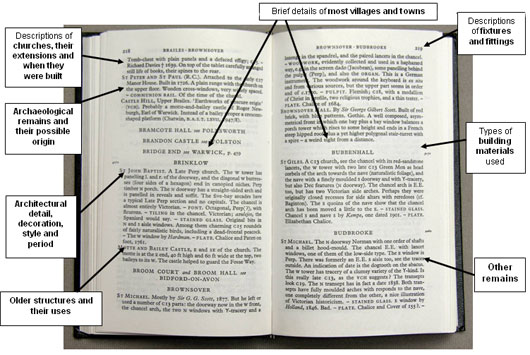The Buildings of England Warwickshire
Description:
During the 1950s, 60s and 70s, the architectural historian, Nikolaus Pevsner, wrote a series of architectural guides to the most significant buildings across Britain. Since this time these guides have continued to be expanded and updated. These guides are arranged on a county-by-county basis providing descriptions of buildings that Pevsner and his co-authors considered as of interest. The guide for Warwickshire (written with Alexandra Wedgwood) lists buildings in all of the county's towns and villages, including Warwick, Kenilworth, Stratford-upon-Avon and Coventry, as well as detailing the numerous country houses and gardens. There is also a useful glossary of architectural terms. The series is currently being revised and are now called and sold as Pevsner Architectural Guides by Yale University Press.
Figure 8: Excerpt from Pevsner's work in Warwickshire

Reproduced with kind permission of the Buildings Book Trust
Click here for larger image
Uses:
Pevsner's guides are especially useful when researching the history of buildings or urban development. They provide an architectural description of buildings and usually some historical detail. However it must be remembered that the guides do not provide a comprehensive list and only describe a building as it was when seen by Pevsner or one of the more recent writers. The descriptions are also sometimes highly subjective and idiosyncratic. Pevsner was mainly interested in polite architecture, whilst much vernacular architecture is ignored completely. The guides also tend to be written from an architectural rather than historical or archaeological point of view. Further research may be needed on specific buildings, but the Pevsner guides, like other secondary sources, provide a useful starting point when researching local history. The guides are especially useful when used in conjunction with listed building descriptions, which can be obtained from the Historic Environment Record or downloaded via the Images of England website (http://www.imagesofengland.org.uk/).
Where to find this source:
- Local Libraries
- Bookshops
- Historic Environment Record

